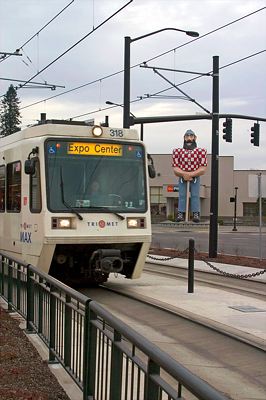Let’s say you want to build a rail line and you are convinced, despite all the evidence in my previous posts, that operating it will use less energy per passenger mile than buses or cars. Before you start construction, first ask: How much energy will it take to build the rail line?
Sound Transit, which is building one of the most expensive light-rail lines in the country and is asking voters for money to build another 50 miles that will cost even more, estimates that one of these lines will save 14,000 tons of CO2 emissions per year. But, based on the environmental impact statement for the line, a group called the Coalition for Effective Transit estimates that constructing the line will use enough energy to emit 640,000 tons of CO2. That’s about 45 years’ worth of savings.
That estimate is based on the “generous assumption” that half the energy needed for construction will come from hydroelectric power. I am not that generous. All hydroelectric power in the Northwest is fully committed to existing energy uses. Besides, electricity is not a significant power source for major construction projects. New energy demands, such as that needed to build a rail line, must come from other sources — sources that will emit thousands of tons of CO2.
Either way, rail lines must be virtually rebuilt from the ground up, requiring a great deal of energy, every 30 years or so. If the energy used to build the line costs more than 30 years worth of your savings, you aren’t saving energy at all. (Highway construction requires energy as well, but because roads are so much more heavily used than rail lines, the energy cost of highway construction per passenger mile is very low.)

Portland’s Interstate Avenue light-rail line was projected to save energy, but the energy cost of construction was 172 times the annual energy savings.
Flickr photo by ahockley.
The environmental impact statement for Portland’s North Interstate light rail estimated that the line would save about 23 billion BTUs per year, but that construction would cost 3.9 trillion BTUs. Thus, it would take 172 years for the savings to repay the construction cost. Remember, since more energy will be needed to rebuild the line every 30 years or so, the energy cost of construction will never be made up for by operational savings. Plus, we know that when this line opened in 2004, light-rail’s average energy consumption actually increased.
In Denver, the environmental impact statement for the West light-rail line admitted (on page 5-76) that light-rail operations would use more energy than either the no action alternative or the enhanced bus alternative. Planners thoughtfully amortized the estimated energy cost of construction so readers could simply add it to the operational cost.
Unfortunately, some transit planners have neglected to include the energy costs of construction in their supposedly comprehensive environmental impact statements. I can’t find any mention of energy in the table of contents for a light-rail project in Dallas. Just to be sure, I downloaded the 43-megabyte chapter on environmental consequences: the word “energy” does not appear anywhere in the report.
In sum, any claims that rail transit will reduce energy consumption must be met with skepticism unless they are accompanied by evidence that the operational savings will quickly repay the construction cost.








Anti-planner says: “Either way, rail lines must be virtually rebuilt from the ground up, requiring a great deal of energy, every 30 years or so.”
Including the tunnels and bridges? Or just the tracks and railbeds? The equivalent figures for highways are an average 40 years for pavements, 75-100 years for bridges and 100+ for tunnels.
Until you mentioned this I had never “noticed” that highway project evaluations never include construction energy.
Mind you, this point probably won’t close the gap between transit and roads but at least we whouldn’t be artificially widening the gap.